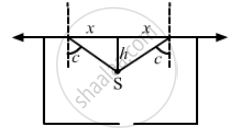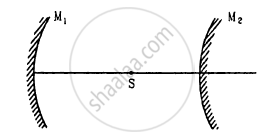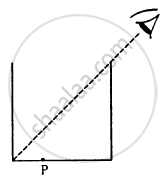Advertisements
Advertisements
प्रश्न
A point source is placed at a depth h below the surface of water (refractive index = μ). (a) Show that light escapes through a circular area on the water surface with its centre directly above the point source. (b) Find the angle subtended by a radius of the area on the source.
उत्तर
Given,
Refractive index is μ
(a)
Let the point source be P, which is placed at a depth of h from the surface of water.
Let us take x as the radius of the circular area.
and let θc be the critical angle.
Thus,
\[\frac{x}{h} = \tan \theta_c \]
\[\frac{x}{h} = \frac{\sin \theta_c}{\sqrt{1 - \sin^2 \theta_c}}\]
\[ = \frac{\frac{1}{\mu}}{\sqrt{1 - \frac{1}{\mu^2}}} \left( \because \sin \theta_c = \frac{1}{\mu} \right)\]
\[\frac{x}{h} = \frac{1}{\sqrt{\mu^2 - 1}}\]
\[x = \frac{h}{\sqrt{\mu^2 - 1}}\]
Clearly from figure, the light escapes through a circular area at a fixed distance r on the water surface, directly above the point source.
That makes a circle, the centre of which is just above P.
(b)
The angle subtended by the radius of the circular area on the point source P:
\[\Rightarrow \sin \theta_c = \frac{1}{\mu}\]
\[\Rightarrow \theta_c = \sin^{- 1} \left( \frac{1}{\mu} \right)\]
APPEARS IN
संबंधित प्रश्न
Fill in the blank:
Very fine particles mainly scatter ………… colored light.
Name the phenomenon responsible for it.
Show with the help of a diagram, how unpolarised light from Sun gets linearly polarised by scattering.
In the meterbridge experimental set up, shown in the figure, the null point ‘D’ is obtained at a distance of 40 cm from end A of the meterbridge wire. If a resistance of 10Ω is connected in series with R1, null point is obtained at AD = 60 cm. Calculate the values of R1 and R2.
What is linearly polarized light?
Describe briefly using a diagram how sunlight is polarised ?
A parallel beam of light is incident on a converging lens parallel to its principal axis. As one moves away from the lens on the other side on its principal axis, the intensity of light
A convex lens is made of a material having refractive index
\[1 \cdot 2\] Both the surfaces of the lens are convex. If it is dipped into water (μ = 1.33), it will behave like
A converging mirror M1, a point source S and a diverging mirror M2 are arranged as shown in figure. The source is placed at a distance of 30 cm from M1. The focal length of each of the mirrors is 20 cm. Consider only the images formed by a maximum of two reflections. It is found that one image is formed on the source itself. (a) Find the distance between the two mirrors. (b) Find the location of the image formed by the single reflection from M2.

Locate the image of the point P as seen by the eye in the figure.

A cylindrical vessel, whose diameter and height both are equal to 30 cm, is placed on a horizontal surface and a small particle P is placed in it at a distance of 5.0 cm from the centre. An eye is placed at a position such that the edge of the bottom is just visible (see figure). The particle P is in the plane of drawing. Up to what minimum height should water be poured in the vessel to make the particle P visible?

A paperweight in the form of a hemisphere of radius 3.0 cm is used to hold down a printed page. An observer looks at the page vertically through the paperweight. At what height above the page will the printed letters near the centre appear to the observer?
Answer the following question in detail.
Is it possible to see primary and secondary rainbow simultaneously? Under what conditions?
Rainbow is the phenomenon due to ______.
A plano-convex lens is made of material having refractive index 1.5. The radius of curvature of curved surface is 40 cm. The focal length of the lens is ____________ cm.
Explain the formation of primary and secondary rainbow.
| Case study: Mirage in deserts |
 |
|
To a distant observer, the light appears to be coming from somewhere below the ground. The observer naturally assumes that light is being reflected from the ground, say, by a pool of water near the tall object. Such inverted images of distant tall objects cause an optical illusion to the observer. This phenomenon is called mirage. This type of mirage is especially common in hot deserts. Based on the above facts, answer the following question : |
In an optical fibre, if n1 and n2 are the refractive indices of the core and cladding, then which among the following, would be a correct equation?
The sky would appear red instead of blue if
A passenger in an aeroplane shall ______.
